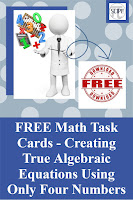Are you ready to take your math skills to the next level? Solving algebraic math puzzles can help you hone your problem-solving skills, increase your analytical and critical thinking skills and boost your confidence in tackling difficult equations. Algebraic math puzzles are a great way to learn the fundamentals of algebra, strengthen your understanding of basic operations and apply core math concepts.
Why task cards? Because task cards can target a specific math skill or concept while allowing the students to only focus on one problem at a time. This format prevents mathphobics from feeling overwhelmed and provides them a sense of accomplishment when a task is completed. Furthermore, the students are more engaged and often acquire a more in-depth understanding of the math concept. By trying new and different strategies and modifying their process, students will be more successful with each puzzle they solve.
The math task cards my students use contain two different math
puzzles. The puzzles vary in difficulty from easy to challenging. Since there
are easy, medium level and challenging puzzles, differentiation is made simple by
choosing the level of difficulty appropriate for each student or team.
Each math puzzle is a square divided into four parts with a
circle in the middle of the square. Each math puzzle contains four numbers, one
in each corner of the square, with the answer in the circle. Using the four
numbers, (each number must be used once) the student is to construct an
equation that equals the answer contained in the circle. Students may use all
four signs of operation (addition, subtraction, multiplication, division) or
just one or two. In addition, each sign of operation may be used more than
once. Parenthesis may be needed to create a true equation, and the Order of
Operations (PEMDAS) must be followed.
Here is an example of what I mean.
 |
| FREE |
These task card or math puzzles can be used…
- At math centers
- As a math problem solving activity for students who finish early
- As enrichment work
- To give students extra practice with a math concept or skill
- As individual work
- In small groups
- As partner work
A free resource containing three such task cards is available at my TPT store.
I believe that math puzzles are key to getting students interested in mathematics, developing their skills, and creating an environment that makes learning enjoyable. So, let's unlock the door to learning with math puzzles and task cards!
_________________________________________________________
By the way, I didn't want to leave you without providing you with the answer to the above puzzle. It is...














